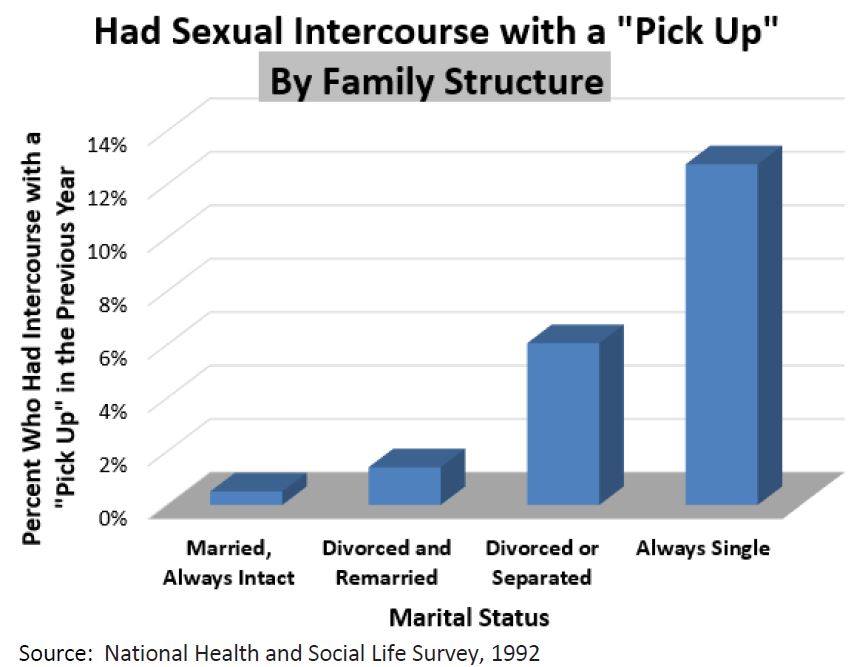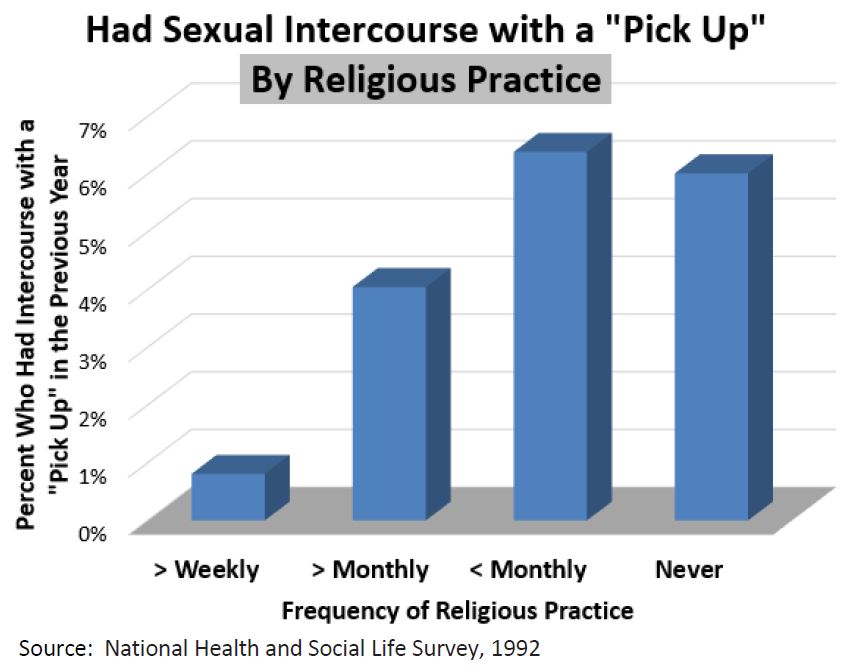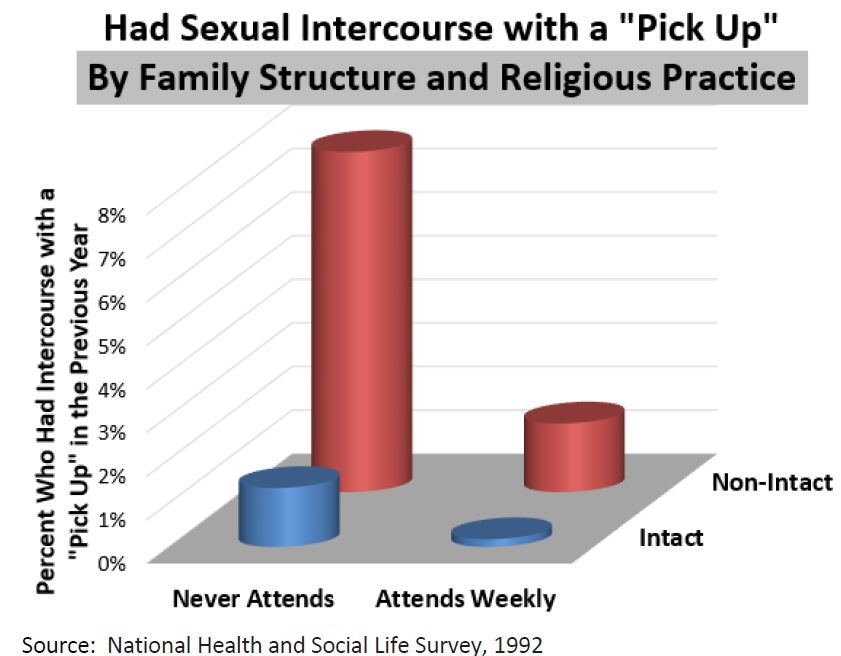Click Here to download “Had Sexual Intercourse with a “Pick-Up” by Family Structure and Religious Practice”
Had Sexual Intercourse with a “Pick-Up” by Family Structure and Religious Practice
The 1992 National Health and Social Life Survey shows that, of adults aged 18 to 59, those in intact marriages who worshipped weekly were least likely to have had intercourse with a “pick-up” in the previous year.
[1]
Family Structure: Those in always-intact marriages were least likely to have had intercourse with a “pick-up” in the previous year (.5 percent), followed by those who were divorced and remarried (1.4 percent), those who were divorced or separated (6.1 percent), and those who were always single (12.8 percent).
 Religious Practice:
Religious Practice: Those who worshipped weekly at the time of the survey were far less likely to have had intercourse with a “pick-up” in the previous year (.8 percent) than those who worshipped less than weekly but at least monthly (4 percent), those who never worshipped (6 percent), and those who worshipped less than monthly (6.4 percent).
 Family Structure and Religious Practice Combined:
Family Structure and Religious Practice Combined: Those in intact marriages who worshipped weekly were, by far, the least likely to have had intercourse with a “pick-up” in the previous year (.2 percent). Those in intact marriages who never worshipped (1.4 percent) and those who worshipped weekly in non-intact family structures or who were single (1.6 percent) were somewhat more likely to have had intercourse with a “pick-up.” Those in non-intact family structures or who were single who never worshipped were dramatically more likely to have had intercourse with a “pick-up” (7.8 percent).
 Related Insights from Other Studies:
Related Insights from Other Studies: An analysis of 919 undergraduate university women found that those who identified as conservative Protestants were less likely to “hook up” (defined as “a physical encounter” without the expectation of “anything further”), but their reduced likelihood was mediated by their self-rated religiosity and frequency of religious attendance. Catholic women were more likely to “hook up.”
[2] However, in its bivariate analysis, the study showed that though a larger proportion of Catholic women who attended church infrequently and did not rate themselves as particularly religious had “hooked up” than those who were religiously nonaffiliated, a smaller proportion of Catholic women who worshiped weekly and reported being very religious had done so.
[3] It would appear that religious attendance, and not only reported religious affiliation, contributes to one’s likelihood to “hook up.”
Analysis of a sample of 459 undergraduate students at a large southeastern public university found that students who reported worshiping less frequently and students who reported little religious feeling were more likely to participate in sexual activities, such as intercourse and oral sex, within the context of a “hook up.” (A “hook up” was simply defined as “[a] sexual encounter between people who are strangers or brief acquaintances. This encounter may be limited to behaviors other than intercourse. There is no expectation of any relationship with this person beyond this sexual encounter.”)
[4]
[1] These charts draw on data collected by the 1992 National Health and Social Life Survey
[2] Amy M. Burdette, Christopher G. Ellison, Terrence D. Hill, and Norval D. Glenn, ““Hooking Up” at College: Does Religion Make a Difference?”
Journal for the Scientific Study of Religion 48, no. 3 (2009): 544.
[3] Amy M. Burdette, Christopher G. Ellison, Terrence D. Hill, and Norval D. Glenn, ““Hooking Up” at College: Does Religion Make a Difference?”
Journal for the Scientific Study of Religion 48, no. 3 (2009): 545.
[4] Tina Penhollow, Michael Young, and William Bailey, “Relationship between Religiosity and ‘Hooking Up’ Behavior,”
American Journal of Health Education 38, no. 6 (2007): 341.]]>
 Religious Practice: Those who worshipped weekly at the time of the survey were far less likely to have had intercourse with a “pick-up” in the previous year (.8 percent) than those who worshipped less than weekly but at least monthly (4 percent), those who never worshipped (6 percent), and those who worshipped less than monthly (6.4 percent).
Religious Practice: Those who worshipped weekly at the time of the survey were far less likely to have had intercourse with a “pick-up” in the previous year (.8 percent) than those who worshipped less than weekly but at least monthly (4 percent), those who never worshipped (6 percent), and those who worshipped less than monthly (6.4 percent).
 Family Structure and Religious Practice Combined: Those in intact marriages who worshipped weekly were, by far, the least likely to have had intercourse with a “pick-up” in the previous year (.2 percent). Those in intact marriages who never worshipped (1.4 percent) and those who worshipped weekly in non-intact family structures or who were single (1.6 percent) were somewhat more likely to have had intercourse with a “pick-up.” Those in non-intact family structures or who were single who never worshipped were dramatically more likely to have had intercourse with a “pick-up” (7.8 percent).
Family Structure and Religious Practice Combined: Those in intact marriages who worshipped weekly were, by far, the least likely to have had intercourse with a “pick-up” in the previous year (.2 percent). Those in intact marriages who never worshipped (1.4 percent) and those who worshipped weekly in non-intact family structures or who were single (1.6 percent) were somewhat more likely to have had intercourse with a “pick-up.” Those in non-intact family structures or who were single who never worshipped were dramatically more likely to have had intercourse with a “pick-up” (7.8 percent).
 Related Insights from Other Studies: An analysis of 919 undergraduate university women found that those who identified as conservative Protestants were less likely to “hook up” (defined as “a physical encounter” without the expectation of “anything further”), but their reduced likelihood was mediated by their self-rated religiosity and frequency of religious attendance. Catholic women were more likely to “hook up.”[2] However, in its bivariate analysis, the study showed that though a larger proportion of Catholic women who attended church infrequently and did not rate themselves as particularly religious had “hooked up” than those who were religiously nonaffiliated, a smaller proportion of Catholic women who worshiped weekly and reported being very religious had done so.[3] It would appear that religious attendance, and not only reported religious affiliation, contributes to one’s likelihood to “hook up.”
Analysis of a sample of 459 undergraduate students at a large southeastern public university found that students who reported worshiping less frequently and students who reported little religious feeling were more likely to participate in sexual activities, such as intercourse and oral sex, within the context of a “hook up.” (A “hook up” was simply defined as “[a] sexual encounter between people who are strangers or brief acquaintances. This encounter may be limited to behaviors other than intercourse. There is no expectation of any relationship with this person beyond this sexual encounter.”)[4]
[1] These charts draw on data collected by the 1992 National Health and Social Life Survey
[2] Amy M. Burdette, Christopher G. Ellison, Terrence D. Hill, and Norval D. Glenn, ““Hooking Up” at College: Does Religion Make a Difference?” Journal for the Scientific Study of Religion 48, no. 3 (2009): 544.
[3] Amy M. Burdette, Christopher G. Ellison, Terrence D. Hill, and Norval D. Glenn, ““Hooking Up” at College: Does Religion Make a Difference?” Journal for the Scientific Study of Religion 48, no. 3 (2009): 545.
[4] Tina Penhollow, Michael Young, and William Bailey, “Relationship between Religiosity and ‘Hooking Up’ Behavior,” American Journal of Health Education 38, no. 6 (2007): 341.]]>
Related Insights from Other Studies: An analysis of 919 undergraduate university women found that those who identified as conservative Protestants were less likely to “hook up” (defined as “a physical encounter” without the expectation of “anything further”), but their reduced likelihood was mediated by their self-rated religiosity and frequency of religious attendance. Catholic women were more likely to “hook up.”[2] However, in its bivariate analysis, the study showed that though a larger proportion of Catholic women who attended church infrequently and did not rate themselves as particularly religious had “hooked up” than those who were religiously nonaffiliated, a smaller proportion of Catholic women who worshiped weekly and reported being very religious had done so.[3] It would appear that religious attendance, and not only reported religious affiliation, contributes to one’s likelihood to “hook up.”
Analysis of a sample of 459 undergraduate students at a large southeastern public university found that students who reported worshiping less frequently and students who reported little religious feeling were more likely to participate in sexual activities, such as intercourse and oral sex, within the context of a “hook up.” (A “hook up” was simply defined as “[a] sexual encounter between people who are strangers or brief acquaintances. This encounter may be limited to behaviors other than intercourse. There is no expectation of any relationship with this person beyond this sexual encounter.”)[4]
[1] These charts draw on data collected by the 1992 National Health and Social Life Survey
[2] Amy M. Burdette, Christopher G. Ellison, Terrence D. Hill, and Norval D. Glenn, ““Hooking Up” at College: Does Religion Make a Difference?” Journal for the Scientific Study of Religion 48, no. 3 (2009): 544.
[3] Amy M. Burdette, Christopher G. Ellison, Terrence D. Hill, and Norval D. Glenn, ““Hooking Up” at College: Does Religion Make a Difference?” Journal for the Scientific Study of Religion 48, no. 3 (2009): 545.
[4] Tina Penhollow, Michael Young, and William Bailey, “Relationship between Religiosity and ‘Hooking Up’ Behavior,” American Journal of Health Education 38, no. 6 (2007): 341.]]>
